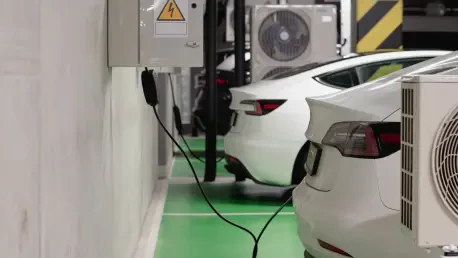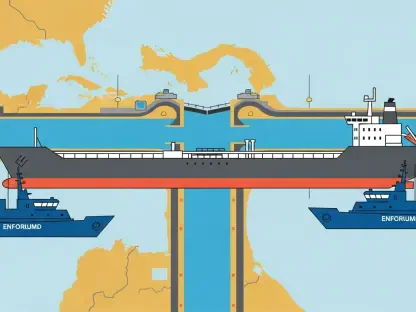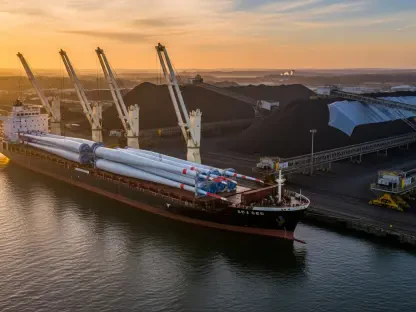As the United States accelerates toward a cleaner energy future, a pressing challenge looms large on the horizon: the nation’s supply chains may not be equipped to handle the skyrocketing demand for wind, solar, and battery technologies. Fueled by the explosive growth of artificial intelligence (AI), the electrification of transportation, and the proliferation of data centers, this demand has pushed the energy infrastructure to its limits. A recent study from Johns Hopkins University, published in npj Clean Energy, paints a sobering picture of vulnerabilities that threaten to derail energy security and climate ambitions. The research reveals a stark mismatch between the resources available and the needs of a rapidly evolving energy landscape, urging immediate action to prevent potential crises.
This critical gap extends beyond mere numbers, encompassing a tangled web of material shortages, systemic inefficiencies, and external risks. Essential raw materials like nickel, aluminum, and silicon—vital for clean energy components—are in short supply, a problem compounded by regulatory bottlenecks and limited domestic production. With the U.S. projected to achieve only 65% of its energy targets by 2050 under current conditions, the consequences of inaction could be severe, ranging from widespread power outages to escalating electricity costs. Addressing these challenges is no longer optional but a fundamental necessity for sustaining progress.
Supply Chain Vulnerabilities
Material Shortages and Infrastructure Strain
The foundation of the clean energy transition rests on access to critical materials, yet the U.S. faces a significant shortfall in resources like nickel, aluminum, and silicon, which are indispensable for manufacturing solar panels, wind turbines, and lithium-ion batteries. This scarcity is not a new issue but has been amplified by the unprecedented rise in energy needs across multiple sectors. Even before the recent surge driven by technological advancements, the nation struggled to keep pace with electrification demands in transportation and industry. The Johns Hopkins study underscores that without a dramatic overhaul of supply chains, the gap between availability and need will widen, posing a direct threat to the clean energy agenda. This material deficit acts as a choke point, stalling the production of essential technologies at a time when scaling up is most critical. The implications extend to national energy goals, with long-term targets appearing increasingly out of reach under the current framework.
Beyond raw materials, systemic challenges further complicate the landscape, with regulatory hurdles and inadequate infrastructure playing significant roles in hampering progress. The research team developed a sophisticated optimization model to simulate supply chain dynamics from now through 2050, incorporating variables such as material costs, manufacturing capacity, and policy constraints. Their findings reveal a troubling reality: even if material shortages were resolved, bottlenecks in permitting processes and outdated grid systems would still prevent the U.S. from meeting consumer demand. These structural inefficiencies highlight the need for a comprehensive approach that addresses not just resource availability but also the mechanisms for deployment. Delays in approvals for new energy projects, coupled with aging infrastructure, create a domino effect, slowing the transition and risking economic repercussions from unmet energy needs.
External Risks and Dependencies
The U.S. energy supply chain is also at the mercy of global uncertainties, with heavy reliance on foreign imports for critical materials introducing substantial risks. Trade wars, tariffs, and geopolitical tensions can disrupt the steady flow of resources, leaving the nation vulnerable to sudden shortages. Whether sourcing from stable allies or less predictable autocratic regimes, this dependency creates a fragile foundation for the clean energy transition. The Johns Hopkins study warns that such external factors could exacerbate existing challenges, especially as demand continues to climb. A single disruption in the international supply chain could cascade through the system, halting production and delaying critical projects. This precarious situation underscores the urgent need to rethink reliance on global markets and prioritize strategies that enhance self-sufficiency.
Compounding these external risks is the dramatic increase in energy consumption driven by emerging technologies like AI and the expansion of data centers. These sectors have introduced an unexpected spike in electricity needs, pushing existing infrastructure beyond its capacity. Combined with the ongoing electrification of transportation, this trend has placed the clean energy transition at a critical turning point. The research highlights that current systems are ill-prepared to handle such rapid growth, with potential consequences including grid instability and service interruptions. This surge in demand serves as a stark reminder that supply chain vulnerabilities are not static but evolve with technological and societal shifts. Addressing these dynamic challenges requires forward-thinking policies that anticipate future needs rather than merely reacting to present constraints.
Proposed Solutions and Strategies
Domestic Capacity and Innovation
To bridge the alarming gap between clean energy demand and supply, the Johns Hopkins study advocates for a significant boost in domestic production and recycling capabilities. Expanding mining operations for critical materials within U.S. borders, alongside advancements in recycling technologies, could reduce dependence on volatile international markets. Lead author Yury Dvorkin emphasizes the importance of adaptive strategies to build a more resilient supply chain, suggesting that new projects and secondary material recovery systems are essential steps forward. Policymakers have a key role to play by offering subsidies, tax incentives, and streamlined regulations to accelerate these initiatives. Such measures would not only enhance resource availability but also create economic opportunities through job growth in the energy sector. The focus on domestic capacity represents a proactive shift toward self-reliance, aiming to insulate the nation from external shocks.
Equally important is the push for technological innovation to find alternatives to scarce materials, a solution that could transform the clean energy landscape. The study calls for increased government funding and public-private partnerships to drive research into substitute resources and more efficient production methods. Developing new materials or optimizing existing ones could alleviate pressure on limited supplies, ensuring that production keeps pace with demand. This approach requires a long-term commitment to scientific exploration, supported by policies that encourage collaboration between industry and academia. By investing in innovation, the U.S. can position itself as a leader in clean energy technology, reducing the risks associated with material shortages. This dual focus on capacity building and research offers a robust framework for overcoming current limitations and securing a sustainable energy future.
Global Partnerships and Risk Management
While domestic efforts are crucial, the complexity of global supply chains necessitates strategic international collaboration to secure a stable flow of critical materials. The researchers recommend forging trade agreements and partnerships with reliable allies to mitigate the risks posed by geopolitical instability and trade disruptions. Such alliances could provide a buffer against sudden shortages, ensuring that the U.S. maintains access to essential resources even in turbulent times. This diplomatic approach requires careful navigation of international relations, balancing economic needs with security considerations. By diversifying supply sources through cooperative frameworks, the nation can reduce its vulnerability to any single point of failure in the global market. These partnerships serve as a vital complement to domestic initiatives, creating a more balanced and resilient energy strategy.
Another key recommendation from the study involves the creation of strategic reserves for critical materials, alongside comprehensive risk management practices. Establishing stockpiles of essential resources would act as a safeguard against supply chain shocks, providing a safety net during periods of disruption. This proactive measure, combined with diversified sourcing, could help stabilize the energy sector in the face of unpredictable global conditions. The research also suggests implementing advanced monitoring systems to anticipate potential interruptions, allowing for swift responses to emerging threats. Lead author Yury Dvorkin highlights that adaptability in supply chain management is fundamental to navigating these challenges effectively. Reflecting on the insights gained, it’s evident that the path taken involved meticulous planning and bold policy moves to address vulnerabilities. These efforts laid the groundwork for a more secure energy landscape, demonstrating that with coordinated action, significant strides were made toward sustainability and resilience.









